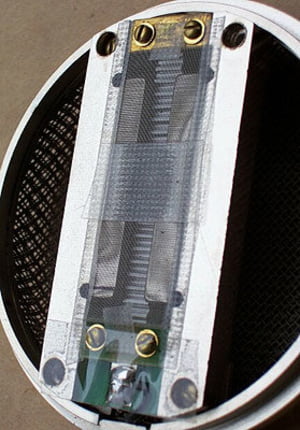3. Working Principle
The Dynamic Principle
Ribbons belong to the category of dynamic microphones. Dynamic microphones are passive, i.e. they dont require a power supply. The most common form of the dynamic microphone is the moving coil microphone. The ever popular Shure SM58, for instance, is a moving coil mic, as are many, many other stage microphones. Moving coil mics are similar to loudspeakers: Theres a coil affixed to the backside of a diaphragm, and this coil is surrounded by a magnet. When sound waves hit the diaphragm, the coil begins to move in its magnetic gap. This movement inside the magnetic field produces a small current in the coil that is in direct relation to the sound waves. And thats exactly what a microphone is supposed to do: sound is turned into a small voltage, an electrical signal. If we take that voltage, amplify it and feed it to a loudspeaker, which, as has been said, is constructed very similarly, the exact opposite is going to happen: our electrical signal is turned into sound again. Ah, the wonders of technology!
The Ribbon Microphone in Particular
The ribbon microphone uses essentially the same working principle, but is far more delicate both in sound and construction. One drawback of the moving coil microphone is that there is a relatively high mass that has to be moved by the sound waves. The diaphragm is relatively thick and has to bear a copper wire coil on its back. Instead of a diaphragm, the ribbon microphone merely uses an ultra-thin aluminium ribbon. This very light strip of aluminium is placed between two magnet poles. If sound waves hit the ribbon, it moves to their rhythm and a very, very small electric current is produced inside the ribbon. So theres a good thing and a bad thing: on the one hand, the ribbon is incredibly light and can follow the sound waves very accurately, much more so than the heavy moving coil mic. But on the other hand, the amount of energy created is incredibly low. Too low, actually, to drive a microphone preamp.
Ribbon Mics Use Transformers
Thats why a ribbon microphone always includes a transformer. A transformer is basically just two coils in close proximity. If you feed an AC voltage (which is what the ribbon element produces) to the primary coil, you get an AC voltage on the secondary coil that looks (i.e. sounds) exactly like the one on the input. Thats pretty boring, so far. But it gets more interesting once one of the coils has more turns than the other. You know this from power transformers: 230 volts can be transformed into, say, 10 volts. That means the winding ratio between primary and secondary of this power transformer is 23:1. But a transformer can also work the other way around and transform a small voltage into a higher voltage. A ribbon mic transformer usually has a ratio between 1:20 and 1:40. As a side effect, the impedance is also transformed. The ribbon element itself has an impedance of less than 1 ohm. The transformer turns this into an impedance in the usual range of 200-600 ohms. Despite the powerful transformer boost, a ribbon is typically lower output than a moving coil dynamic mic, let alone condensers. So you need a decent microphone preamp to be able to take full advantage of a ribbon microphone.
New Development: Active Ribbon Mics
Because ribbon microphones are low output and require a lot of clean gain in many applications, some clever guys devised ribbon microphones with internal preamp electronics. There's hardly any microphone preamp or mixer that does not offer phantom power for condenser mics. So why not use that power for ribbons, too? The best known phantom powered active ribbon microphones are made by Royer Labs. But other manufacturers such as Sontronics have followed their suit. Beware: Do not apply phantom power to any ribbon microphone other than these active phantom powered ribbons. Normal passive ribbon microphones can be damaged by phantom power!


